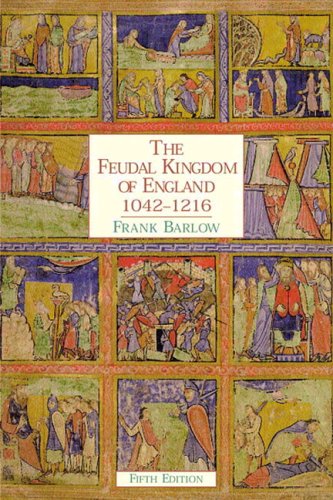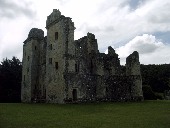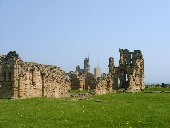The Medieval World
Medieval World Information
News
- coming soon
Links
Site Info
Welcome, Guest
Did social divisions in England widen or narrow during the period 1066 to c.1250?
An essay by Rølf SilverI will argue that the pre-existing ruling class was replaced by a Norman aristocracy, in the first couple of centuries after the Norman conquest. This had a long-lasting impact on the composition of the British aristocracy, with some effects that are still evident today in patterns of land-ownership. In the process, social stratification intensified greatly.
Barlow argued that the "Norman achievement was to re-establish traditional English monarchy, modify it to suit the new conditions and develop it pragmatically as need arose." (Barlow, 1966) He argued that the Normans neither destroyed all English culture and traditions nor were absorbed into their new environment. The impact on English life was only complete after the Angevin take-over in 1154 by which time England was almost like a French province, but it never became one, partly because of the very nature of Norman rule. The Normans were willing to control the indigenous population and to use the natives' ideas to their own advantage, without themselves adopting the local language and customs.
William invaded to advance his claim to the throne. He was very keen to gain access to the power and resources associated with English kinghip. He then faced rebellions from members of upper levels of Anglo-Germanic society, who resented his refusal to grant office to them. In pursuit of, and as a consequence of, the resulting war of attrition against members of the pre-existing ruling class, William rewarded his followers with land and oversaw a massive militarisation of society. Within a short period, the traditional aristocracy was completely replaced by Normans loyal to William.
For example, two-thirds of England was ruled by men of English birth and parentage up to 1069. By 1086, only two English men were recorded as holding baronial-size estates and only eight per cent of the land remained in possession of Englishmen. (Furneaux, R 1966 p:189)
The king reserved huge portions of land to himself. After taking a fifth of the arable land, he distributed the rest among his followers and kin. He granted earldoms as rewards for service, with rights to rent and to military occupation. These grants were made in return for vassal duties, involving loyalty and provision of military service. Militarisation of the estates led to the construction of private castles, many with mottes.
Although this series of enfeoffments is often seen as having introduced Norman feudalism to England, Barlow argued rather that it was a new form of feudalism, which differed from both Norman and Anglo-Germanic social relations in concepts and structure. (p138) The kingdom was divided into great fiefs, with the barons being the king's vassals, who in turn granted fiefs to their own vassals. The king was the ultimate end of the chain of feudal relations of homage and fealty.
None of the social relations represented a complete break with the past. Kingship and lordship were institutions that predated the Conquest. The effect of the Conquest was to greatly strengthen the roles of kingship and lordship. This concentration of power and ownership of the means of medieval production (i.e. land) in the hands of a small aristocracy, closely dependent on royal favour, set up the English class system which persisted in shaping British history until the Industrial Revolution brought some changes in the nature of British class.
He sought legitimacy through reference to the church (he was crowned by a papal legate, his wife by the archbishop of York; the Normans did penance for sins committed in the war.) There was a Normanisation of the church, with limited moral reform but a more successful reorganisation of church administration. Many cathedrals and churches were built. Native saints were discarded. In the church, as in the wider society, the social divisions increased. The English church remained a national church with the king at its head, able to face conflict with Roman authorities when necessary. According to Barlow, the Conquest facilitated the spread of new religious ideas from Europe but the impact of these ideas was delayed by the very fact of the strong Norman kingship.
William also set up legal and administrative systems to control the country. One effect of the strengthening of kingship and the implementation of Norman feudal relations was, paradoxically, that the militarisation of society was actually reduced. The evidence suggests that, after the first decade of Norman rule - when William made use of all possible soldiers as resources - the general tendency was to reduce duties to serve when compared to the pre-Norman rulers' demands. Military service obligations were increasingly transformed into revenues, used to hire professional troops rather than ill-prepared farmers. There was also increasing resort to courts to deal with disputes, rather than to military force.
The strengthening of kingship was accompanied by a re-endowment of the monarchy, adding private estates to royal demesnes with changes of dynasty. Geld (tax on estates) was reinstated. Feudal rights were fully exploited. A body of law, based on French customs but adapted for English conditions, was set up. The King's court law became the basis for common law. Kings became more frequent absentees. By tradition an absent king could be represented by a servant. The practice was institutionalised in 1109, when Henry I appointed standing deputies, each with a fixed local court, the exchequer. The kings' own courts came to oversee local courts and became responsible for enforcing justice. Henry revived the local courts and widened the scope of his own, bringing the two systems into conjunction. He sent the king's justiciars on circuit. The Normans devised more efficient administration, usually by introducing English solutions, with little advance on previous practice, according to Barlow. Henry I also decided that justiciars should audit the accounts of financial agents in their exchequer courts. Relatively accurate records were increasingly made and kept, (e.g. the Domesday Book, 1085/6.)
Over the whole Norman and Angevin period, royal power increased vis a vis the feudal lords. The strengthening of kingship, at the same time as the rights of the nobility, produced ongoing disputes between the king and barons, which gave rise to the British constitution.
The issue of the effects of rule by a foreign ruling class can be exaggerated, given that the Anglo-Germanic-Danish pre-conquest ruling class was not truly native in origin. The native population was long accustomed to being ruled by invaders. However, William and his successors spent as much time outside the country as they could, preferring to act as absentee landlords of the country, at first, only returning when forced to defend their gains. They were less educated and cultivated than the Anglo-Germanic nobility. They were unwilling to speak English. Over the following two centuries, the Norman aristocracy came to adopt some English customs and the English to adopt some Norman customs. In general, however, the overall cultural impact was to broaden social divisions.
The basis of English snobbery can be traced to the wide social & linguistic distinctions between rulers and ruled. The royal family and the aristocracy use Norman vowel sounds. Accents which do not make use of Norman vowel sounds (such as those of Newcastle, Birmingham or Liverpool) are still disparaged as lower class. (E.g the "a" in "bath" the "u" in "butter" can show one's likely "class" roots in broad terms). For example, English words used as curses tend to be those of Anglo-Saxon origin.
In Anglo-Saxon society, women's position was relatively good. They could hold land and bequeath it to whom they chose. Norman society strongly upheld masculine values. Under Norman rule, the rights of women were greatly reduced, although some rights were regained in the later Norman era.
In summary, the Normans did not so much set up new relations of production as develop the existing feudal relations to work in their favour. Their control of agricultural production was underpinned by their access to legitimacy (through the church and the legal system) and their definition of cultural values (through language, architecture, styles of dress, and so on.) They made use of existing English systems and used them efficiently to consolidate the power of the ruling group - themselves. They formalised social conflict by spreading legal and administrative resolutions of problems. They also demilitarised English society by formalising relations between king and barons in a complex web of fealty and obligation, while demanding less military service obligations from clients and more money to pay for professional soldiers. Kingship and lordship (both based on Norman origin) were strengthened while the common people's rights were increasingly eroded. The impact of power struggles between king and barons would shape British political history for several hundred years to come and determine the shape of the British constitution. However, king and lords were always mutually dependent, engaged in mutually beneficial relationships. The common people, originally unconcerned and uninterested in changes of royal houses, were to be increasingly tied into relationships that diminished their rights over the land they worked.
Bibliography
Barlow, F (1966) "The effects of the Norman Conquest" in Whitelock, D. et al (1966) "The Norman Conquest" London. Eyre & Spottiswoode (pp122:161)
Furneaux, R (1966) "Conquest 1066" London. Secker and Warburg




